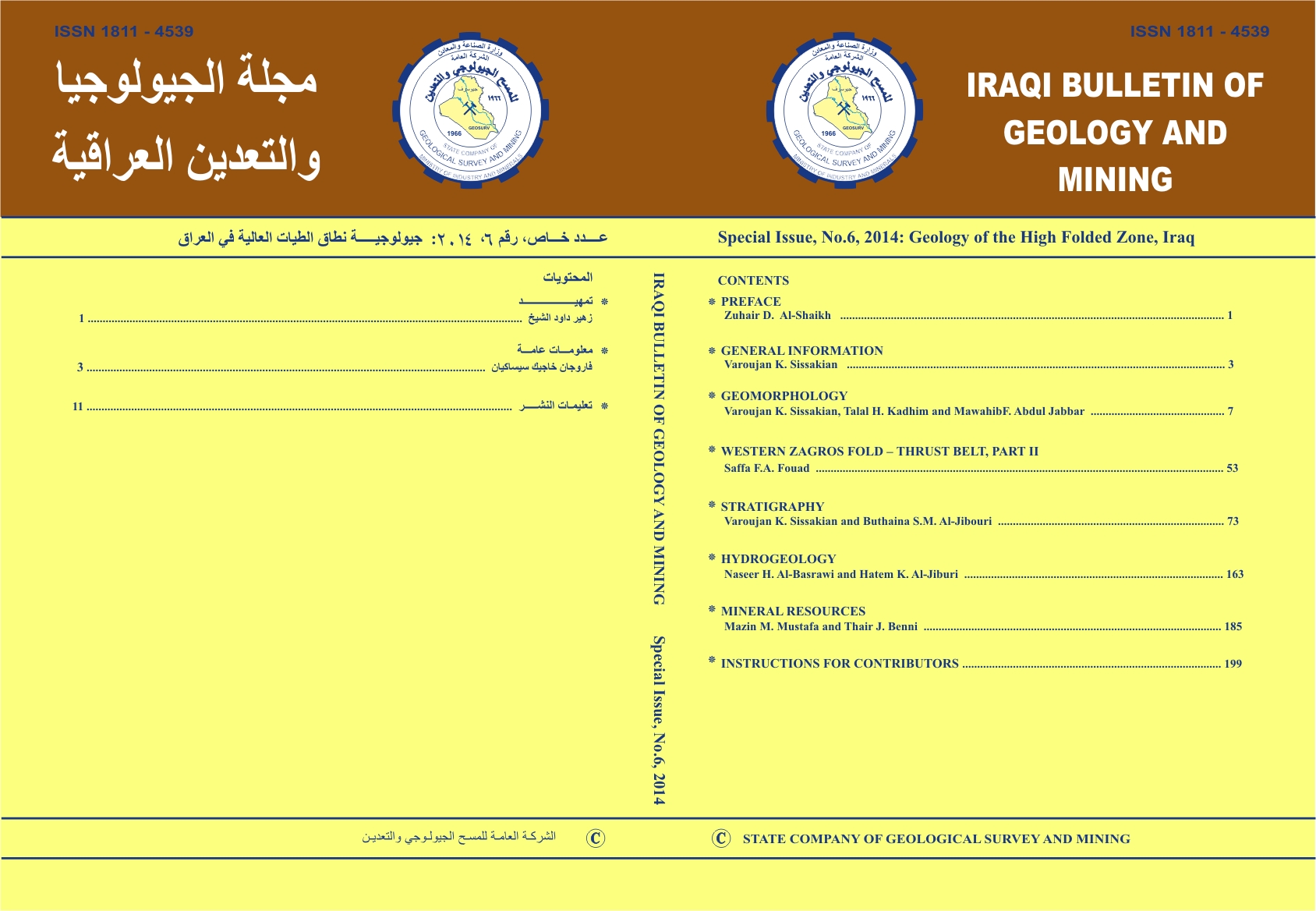Abstract
The geomorphology of the Iraqi High Folded Zone (HFZ) is reviewed in the present article. The High Folded Zone is characterized mainly by mountainous topographic nature. The nature of the topography reflects the type of the exposed rocks and the structural effect. Generally, two main different topographical parts could be recognized, this is attributed to the presence of longitudinal and narrow anticlines and shallow synclines, locally faulted. Moreover, the surface of the HFZ area is dissected by complicated drainage patterns with variable density; they drain the area towards the main streams and rivers, and then toward the Tigris, Greater Zab, Lower Zab and Sirwan rivers. The chemical and mechanical weathering are active, the water is the main erosional agent being also an active process.
A generalized geomorphologic map of the HFZ is compiled, at scale of 1: 1000 000. The map elucidates the spatial distribution of the main geomorphologic units and the related morphologic features. The geomorphologic units are classified genetically into six classes, which include different landforms. The recognized genetic units are: Structural – Denudational, Denudational, Fluvial, Solution, and Man-made origins, and possible Glacial moraine. Each of these units includes different lithomorphologic landforms, which were developed due to weathering, erosion and depositional processes, in conjunction with tectonic, structural, lithological, and climatic factors.
The present study revealed that the geomorphologic evolution of the HFZ was greatly influenced by the last phase of intensive orogenic movement that took place during Late Miocene – Pliocene, and continued during the Quaternary Period with less intensity. During the Quaternary Period, the climate became a leading factor in controlling the majority of geomorphologic processes, particularly the fluvial. The Quaternary long-term climatic changes are deduced by well-developed river terrace stages along the main rivers and their tributaries, and some large streams and valleys, beside numerous alluvial fans and calcrete.
A generalized geomorphologic map of the HFZ is compiled, at scale of 1: 1000 000. The map elucidates the spatial distribution of the main geomorphologic units and the related morphologic features. The geomorphologic units are classified genetically into six classes, which include different landforms. The recognized genetic units are: Structural – Denudational, Denudational, Fluvial, Solution, and Man-made origins, and possible Glacial moraine. Each of these units includes different lithomorphologic landforms, which were developed due to weathering, erosion and depositional processes, in conjunction with tectonic, structural, lithological, and climatic factors.
The present study revealed that the geomorphologic evolution of the HFZ was greatly influenced by the last phase of intensive orogenic movement that took place during Late Miocene – Pliocene, and continued during the Quaternary Period with less intensity. During the Quaternary Period, the climate became a leading factor in controlling the majority of geomorphologic processes, particularly the fluvial. The Quaternary long-term climatic changes are deduced by well-developed river terrace stages along the main rivers and their tributaries, and some large streams and valleys, beside numerous alluvial fans and calcrete.
Keywords
Geomorphological units and forms
High folded zone
Iraq
Water and wind gaps
Abstract
شملت هذه الدراسة مراجعة جيومورفولوجية منطقة نطاق الطيات العالية في شمال وشمال شرق العراق. وأهم الظواهر السطحية الرئيسية في هذه المنطقة تتمثل بكونها منطقة جبلية ذات تضاريس عالية وتتميز بوعورتها، بشكل عام وتتخللها بعض السهول المنبسطة أو قليلة التموج، خاصةً عندما تتكشف فيها صخور ذات صلادة واطئة، والتي تكون مغطاة بشكل عام بترسبات العصر الرباعي. إضافةً إلى ذلك، فإن سطح المنطقة مقطع بواسطة شبكات التصريف السطحي المعقدة ذات الكثافات العالية، وفي مناطق عديدة تكون على شكل مضايق مختلفة الاحجام وألأصل، حيث تقوم شبكات التصريف بصرف مياه المنطقة باتجاه الأنهار والجداول الرئيسية وبالتالي تصب في حوض نهر دجلة، اضافةً الى انهار الزاب ألأعلى والزاب ألأسفل وسيروان والتي بدورها تصب في نهر دجلة خارج المنطقة. تم توليف خريطة جيومورفولوجية مبسطة لمنطقة نطاق الطيات العالية من مقياس 1: 000 1000، وقد وضحت هذه الخريطة التوزيع المكاني للوحدات الجيومورفولوجية الرئيسية، إضافةً إلى بعض الأشكال السطحية الأخرى. وتم تصنيف الوحدات الجيومورفولوجية اعتماداً على المنشأ إلى ستة أصناف وهي الوحدات ذات الأصول, التركيبية – التعروية, التعروية, النهرية, الإذابية, وتلك الناتجة عن فعل الإنسان، وقد توجد ترسبات الثلاجات أيضاً، وتشمل كل من هذه الوحدات الجيومورفولوجية على عدة أشكال أرضية ذات صخارية مختلفة. وقد تكونت هذه الأشكال نتيجة لفعل عمليات التجوية والتعرية والترسيب المقرونة بالعوامل البنيوية والتركيبية والصخارية والمناخية.
وقد توصلت هذه الدراسة إلى أن نشوء جيومورفولوجية منطقة الطيات العالية قد تأثر بشكل كبير بالمرحلة الأخيرة من الحركة ألأوروجينية البانية للجبال (Alpine Orogeny) التي حدثت خلال عصر المايوسين المتأخر وعصر الپلايوسين واستمرت خلال العصر الرباعي ولكن بشدة أقل. خلال العصر الرباعي، أصبح للمناخ دوراً متصدراً في السيطرة على غالبية العمليات الجيومورفولوجية. وقد شهد العصر الرباعي عدة تغيرات مناخية طويلة الأمد تم استنتاجها من خلال تكون عدة مناسيب للمدرجات (المصاطب) النهرية على امتداد الأنهار والجداول الموسمية وبعض ألوديان الرئيسية، وكذلك عشران المراوح الغرينية وترسبات الكالكريت.
وقد توصلت هذه الدراسة إلى أن نشوء جيومورفولوجية منطقة الطيات العالية قد تأثر بشكل كبير بالمرحلة الأخيرة من الحركة ألأوروجينية البانية للجبال (Alpine Orogeny) التي حدثت خلال عصر المايوسين المتأخر وعصر الپلايوسين واستمرت خلال العصر الرباعي ولكن بشدة أقل. خلال العصر الرباعي، أصبح للمناخ دوراً متصدراً في السيطرة على غالبية العمليات الجيومورفولوجية. وقد شهد العصر الرباعي عدة تغيرات مناخية طويلة الأمد تم استنتاجها من خلال تكون عدة مناسيب للمدرجات (المصاطب) النهرية على امتداد الأنهار والجداول الموسمية وبعض ألوديان الرئيسية، وكذلك عشران المراوح الغرينية وترسبات الكالكريت.
